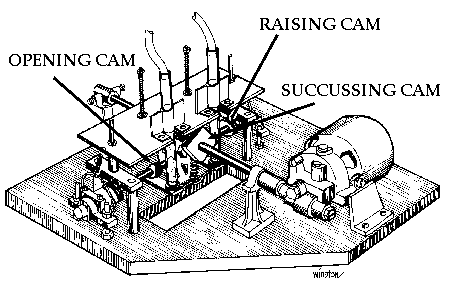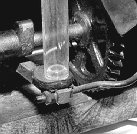 The
Kent Potentizer
The
Kent Potentizer  The
Kent Potentizer
The
Kent Potentizer "We have 900 remedies ran up to the 10M (10,000), 50M (50,000), CM (100,000). These potencies are made with the Dr. James Tyler Kent potentizer. This machine is the most accurate centesimal potentizing implement ever invented. The starting point of these potencies is commenced with the 1000 Ehrhart's hand made potency. The motive power being water pressure. The menstrum which is used for potentizing is filtered water.
"There are four dials on this machine. The dials indicate the actual number of times the receiver has been emptied. This machine differs from all others as the remedy being potentized receives quite a succussion, this no other machine will do. These are the only machine made high potencies on the market that are made with filtered water; all others that we know of are made with the ordinary tap water."
— From the 1920 Catalog
 Little
is known about the history of the Kent Potentizer. That Kent designed it is
alluded to in the Ehrhart and Karl Catalog. Kent himself left no writings about
the machine.
Little
is known about the history of the Kent Potentizer. That Kent designed it is
alluded to in the Ehrhart and Karl Catalog. Kent himself left no writings about
the machine.
The machine was in use from before Kent's death in 1916 probably through the 1940s.
At one point in the late 1970s when Luyties bought much of the equipment from E&K, the potentizer was taken to St. Louis. It remains at the Luyties facility.
I have seen it in partial operation.
The machine held two potentizing tubes, mounted on a flat plate made of a thick piece of Bakelite.
 These
tubes were open at the bottom with a slight return. (Picture at the left).
These
tubes were open at the bottom with a slight return. (Picture at the left).
The hole in the bottom of the tube was stopped with a leather plug, held in place by a cam. (See picture below) When the cam pulled the plug back, the contents of the tube would flow out, but the return held some of the previous content.
 I
make the assumption that the amount in the return was seen as "1"
and the when the tube was re-filled, it then held "99" parts of filtered
water.
I
make the assumption that the amount in the return was seen as "1"
and the when the tube was re-filled, it then held "99" parts of filtered
water.
The machine is powered by a motor that drives an axle. Connected to the axle is a square "succussing cam" and a worm gear, which drives an axle at right angles to the first. This axle holds the "raising cam" and the "opening cam."
The operation is fairly straight-forward.
The one missing piece is the mechanism by which the potentizing tubes were filled.
Forrest Murphy, of Luyties, suggested that, perhaps, the water ran continuously through the tubes, being timed to just fill the tube during the ten succussions.
But, with the accuracy inherent in the the rest of the machine, It is hard to believe that Kent would have accepted such an inaccurate measure.
Although the report in the catalogue speaks of "four dials," none were evident on the machine.
There was obviously some way of feeding a measured amount of water through rubber tubes that fit tightly into the glass potentizing tubes, but the exact mechanism remains a mystery.
There is, unfortunately, no one still alive that has seen the machine in operation.
©2000 Julian Winston